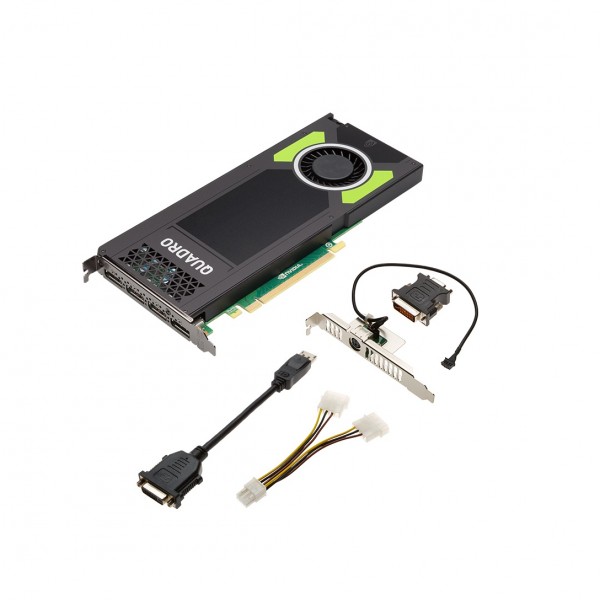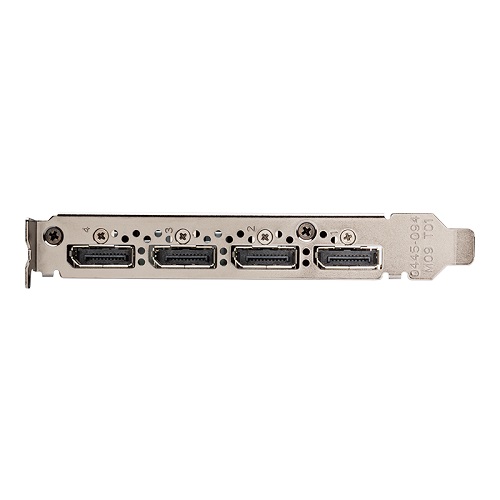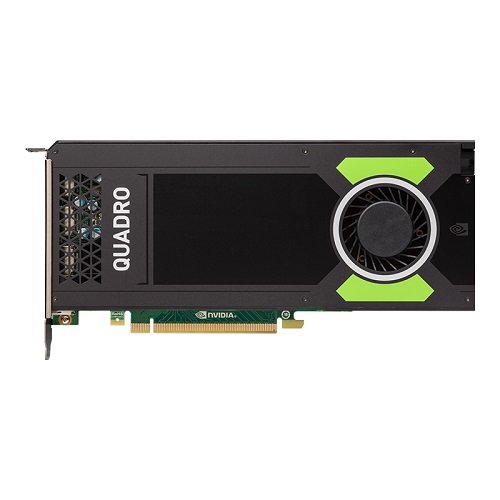UAE Shops - Established in 2002
عربى
Pny Nvidia Quadro M4000 Graphics Cards
CUDA Cores: 1664 GPU Memory: 8 GB GDDR5 Memory Interface: 256-bit System Interface: PCI Express 3.0 x16 Memory Bandwidth: 192 GB/s Display Connectors: DP 1.2 (4) + Stereo Product Description PNY NVIDIA Quadro M4000 Graphics Cards Housing a Maxwell architecture chip, the PNY Technologies Quadro M4000 Graphics Card is optimized for professional graphics rendering. The Maxwell architecture GPU features 1664 CUDA cores coupled to 8GB of GDDR5 vRAM with a 256-bit memory bus providing a maximum of 2.6 TFLOPS of single-precision computing power. Using supported APIs and CUDA, that computing performance can translate into high resolution and realistic real-time 2D and 3D graphics rendering or improved computing speed with hardware acceleration. The output panel on this card features four DisplayPort terminals. Up to four monitors can be simultaneously supported by a single card to create high-resolution video walls with your workstation or for more desktop real-estate to increase productivity. Multiple cards can be used together to expand the card’s multi-display capabilities. Included with the card is a DisplayPort to Single-Link DVI-D adapter so you can run a DVI display off the card. For cooling, PNY implemented NVIDIA’s blower-style cooler. This cooler uses a radial fan to force air through the card’s heatsink and out of the case through the front of the card. This cooling configuration is good for workstation case configurations where space between computer components can be a concern. General Features 3D Graphics Architecture Scalable geometry architecture Hardware tessellation engine NVIDIA GigaThread engine with dual copy engines Shader Model 5.0 (OpenGL 4.5 and DirectX 12) Transparent multisampling and super sampling 16x angle independent anisotropic filtering 128-bit floating point performance 32-bit per component floating point texture filtering and blending Decode acceleration for MPEG-2, MPEG-4 Part 2 Advanced Simple Profile, H.264, MVC, VC1, DivX (version 3.11 and later), and Flash (10.1 and later) Blu-ray dual-stream hardware accelerating (supporting HD picture-in-picture playback) NVIDIA GPU Boost automatically adjusts the GPU engine throughput to maximize application performance. Parallel Computing Capabilities SMX architecture (streaming multi-processor design that delivers greater processing and efficiency) HyperQ (allows multiple CPU cores to simultaneously utilize a single GPU to execute independent compute kernels) API support including: CUDA C, CUDA C++, DirectCompute 5.0, OpenCL, Java, Python, and Fortran NVIDIA Parallel Data Cache hierarchy (per SM L1 and unified L2 caches) 96KB of RAM (dedicated shard memory per SM) Advanced Display Features 30-bit color (10-bit per each red, green, and blue channel) Support for any combination of four connected displays DisplayPort 1.2 (supporting resolutions such as 4096 x 2160 at 60 Hz) DisplayPort to VGA, DisplayPort to DVI (single-link and dual-link), and DisplayPort to HDMI cables optionally available (resolution support based on dongle specifications) 10-bit internal display processing (hardware support for 10-bit scanout for both windowed desktop and full screen, only available on Windows with Aero disabled and Linux) Full OpenGL quad buffered stereo support Underscan/overscan compensation and hardware scaling Support for NVIDIA Quadro Mosaic, NVIDIA NVIEW multi-display technology, NVIDIA Enterprise Management Tools Support for large-scale, ultra-high resolution visualization using the NVIDIA SVS platform which includes NVIDIA Mosaic, NVIDIA Sync, and NVIDIA Warp/Blend technologies GPU Features Maxwell Streaming Multiprocessor The heart of Maxwell’s power efficient performance is its newly designed Streaming Multiprocessor which delivers performance and power efficiency through an improved instruction scheduler and new data path organization. Maxwell Memory Architecture Improved caching effectiveness and enhancements in memory compression techniques in Maxwell reduces traffic and provides higher performance for applications dependent on memory bandwidth. Additionally, Maxwell’s dedicated shared memory per SM (separated from the L1 cache) and larger L2 cache, improves programmability and efficiency. Viewport Multicast Dedicated hardware to automatically broadcast input geometry to render to multiple render targets which drastically speeds up multi-projection (the ability of rendering the same scene from multiple views) leading to accelerated rendering for cube maps used in multi-view projectors and 3D CAVE environments. Sparse Textures Virtualizes texture sizes, enabling applications to seamlessly work with large and complex data sets regardless of the available frame buffer. Accelerated Voxelization Enhancements to voxel handling techniques enables fast voxelization which significantly accelerates workflows like fluid simulation and 3D printing. Multiple Copy Engines Enables the highest rates of parallel data processing and concurrent throughput between the GPU and host, accelerating techniques such as ray tracing, color grading and physical simulation. Bindless Graphics Optimizes GPU utilization by reducing CPU-GPU interactions, enabling developers to implement more sophisticated and complex algorithms providing end users greater performance and higher levels of visual fidelity. H.264 and HEVC Encoder Dedicated H.264 and HEVC encode engine that is independent of 3D/compute pipeline and delivers faster than real-time performance for transcoding, video editing, and other encoding applications. NVIDIA CUDA Architecture Parallel-computing architecture that tightly integrates advanced visualization and compute features to significantly accelerate professional workflows. NVIDIA Scalable Geometry Engine Dramatically improves geometry performance across a broad range of CAD, DCC and medical applications, enabling you to work interactively with complex models and scenes. Dynamic Parallelism Simplifies GPU programming by allowing programmers to easily accelerate all parallel nested loops – resulting in a GPU dynamically spawning new threads on its own without going back to the CPU. Error Correcting Code (ECC) on Graphics Memory Offers enhanced application data integrity protection through single bit memory error correction. NVIDIA GPU Boost Increases application performance through automatic adjustment of the GPU clock to take maximum advantage of the power and thermal headroom of the card in real-time. NVIDIA Multi-GPU Technology NVIDIA Multi-GPU powered workstations combine the visualization and interactive design capability of multiple GPUs, by leveraging any combination of Quadro and Tesla GPUs to intelligently scale the performance of your application and dramatically speed up your production workflow. Image Quality Features Full-Scene Anti-Aliasing (FSAA) Up to 64X FSAA for dramatically reducing visual aliasing artifacts or “jaggies,” resulting in improved image quality and realistic scenes. NVIDIA FXAA and TXAA Reduces visible aliasing and delivers higher image quality without the performance hit by harnessing the power of the GPU’s CUDA cores and new film-style AA techniques. GPU Tesselation Quadro Tessellation Engines automatically generate finely detailed geometry for cinematic quality environments and scenes, without sacrificing performance. 16K Texture and Render Processing Provides the ability to texture from and render to 16K x 16K surfaces. Beneficial for applications that demand high resolution and quality image processing. Display Features NVIDIA Quadro Mosaic Technology Enables transparent scaling of the desktop and applications across up to 16 displays from 4 GPUs from a single workstation while delivering full performance and image quality. Multi-Display Support All-new display engine drives up to four displays simultaneously and fully supports the Display Port 1.2 standard capable of resolutions such as 3840 x 2160 at 60 Hz, making it easy to deploy multiple displays across a desktop, build an expansive digital signage wall, or create a sophisticated stereoscopic 3D CAVE environment. NVIDIA 3D Vision Support When used with a 3D Vision compatible monitor and 3D Vision active-shutter glasses, high-resolution images are delivered to each eye. Additionally, with a 3D LightBoost compatible screen, image brightness will be maintained while using the glasses and ghosting will be reduced. 3D Stereo Synchronization Use the included 3-pin mini-DIN connector to directly synchronize 3D stereo hardware to the GPU for robust control. Deep Color Processing and Display Preserve color detail and precision throughout the processing and display pipeline for smooth gradients transitions, even on high dynamic range imagery. Each color component can be processed at up to 32-bit floating point precision and displayed at up to 12-bit precision with supported DisplayPort 1.2 or HDMI 1.4 displays





